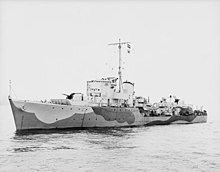
HNoMS Eskdale (pennant number L36) was an escort destroyer of the Type III Hunt class. The destroyer served with the Royal Norwegian Navy. It was sunk by enemy action in 1943. [1] [2]

HNoMS Eskdale (pennant number L36) was an escort destroyer of the Type III Hunt class. The destroyer served with the Royal Norwegian Navy. It was sunk by enemy action in 1943. [1] [2]
Eskdale was one of fifteen Type III Hunt-class destroyers ordered for the Royal Navy on 23 August 1940, as part of the 1940 War Emergency Programme, [3] with 28 Type III Hunts ordered over the course of 1940. [4] The Hunt class was meant to fill the Royal Navy's need for a large number of small destroyer-type vessels capable of both convoy escort and operations with the fleet. The Type III Hunts differed from the previous Type II ships in replacing a twin 4-inch gun mount by two torpedo tubes to improve their ability to operate as destroyers. [5] [6]
The Type III Hunts were 264 feet 3 inches (80.54 m) long between perpendiculars and 280 feet (85.34 m) overall, with a beam was 31 feet 6 inches (9.60 m) and draught 7 feet 9 inches (2.36 m). Displacement was 1,050 long tons (1,070 t ) standard and 1,490 long tons (1,510 t) under full load. Two Admiralty boilers raising steam at 300 pounds per square inch (2,100 kPa) and 620 °F (327 °C) fed Parsons single-reduction geared steam turbines that drove two propeller shafts, generating 19,000 shaft horsepower (14,000 kW) at 380 rpm. This gave a design maximum speed of 27 knots (50 km/h; 31 mph). [7] 345 long tons (351 t) of oil fuel were carried, giving a range of 3,700 nautical miles (6,900 km; 4,300 mi) at 15 knots (28 km/h; 17 mph). [8]
Main gun armament was four 4 inch (102 mm) QF Mk XVI dual purpose (anti-ship and anti-aircraft) guns in two twin mounts, with a quadruple 2-pounder "pom-pom" and three Oerlikon 20 mm cannon providing close-in anti-aircraft fire. [9] [7] Two 21-inch (533 mm) torpedo tubes were fitted in a single twin mount, while two depth charge chutes, four depth charge throwers and 70 depth charges comprised the ship's anti-submarine armament. Type 291 and Type 285 radar was fitted, as was Type 128 sonar. [9] [10]
Eskdale was laid down at Cammell Laird's Birkenhead shipyard on 18 January 1941, was launched on 16 March 1942 and completed on 31 July 1942. [3] [11]
While Eskdale was originally built for the Royal Navy, in June 1942, it was agreed that it would be transferred to the Royal Norwegian Navy under operation of the Norwegian armed forces in exile, with the crew of the Norwegian-manned Town-class destroyer Newport, which was undergoing extensive repair after a collision, taking over the new destroyer, and Newport returning to Royal Navy control on completion of the repairs. Eskdale commissioned on 20 July 1942. [12] [13]
Eskdale initially worked up at Scapa Flow, [12] and on 2 September 1942, Eskdale sailed as part of the escort for the Arctic convoy PQ 18 for the convoy's initial leg from Loch Ewe to Iceland. [14] Eskdale then joined the 1st Destroyer Flotilla based at Portsmouth, taking part in convoy escort and patrol duties in the English Channel and North Sea, serving with the flotilla until the destroyer's sinking. [12] [15]
On the night of 13/14 October 1942, the German Navy attempted to run the commerce raider Komet westwards through the Channel from Le Havre, escorted by four torpedo boats. [lower-alpha 1] . The British were aware of the German attempt, and deployed two groups of ships to intercept the German force. One, consisting of Eskdale, the destroyers Cottesmore, Albrighton, Glaisdale and Quorn, followed by eight Motor Torpedo Boats sailed from Dartmouth to patrol off Cap de la Hague, while a second group of four destroyers were to wait off the Channel Islands. The Motor Torpedo Boats became separated from the Eskdale group of destroyers, which spotted the convoy at about 01:00 on 14 October. The five destroyers took the convoy by surprise, setting Komet on fire and badly damaging T10, while the German defensive fire was ineffective, with fire from Komet hitting three of the German torpedo boats. The British Motor Torpedo Boat MTB 236, which had lost contact with the other MTBs, spotted the battle, and torpedoed Komet at about 01:15 hr. Komet then blew up with the loss of all aboard. [16] [17] On the night of 12 December 1942, Eskdale, together with the destroyers Albrighton, Brocklesby, Vesper, Whitshed and Worcester, attacked a German convoy off Dieppe, with Eskdale torpedoing and sinking the German auxiliary minesweeper Sperrbrecher 144. [18] [19] Eskdale was hit in the bridge during this engagement, and had to be steered from the ship's emergency conning position at the aft end of the ship. Eskdale was under repair until 16 January 1943. [12]
On 14 April 1943, Eskdale and Glaisdale, together with five trawlers, were escorting the six merchant ships of convoy PW-323 (Portsmouth-Wales), when the convoy was attacked by seven German motor torpedo boats (known as Schnellboot to the Germans and E-boats to the British) off Lizard Head. Eskdale was sunk by torpedoes from S90, S65 and S121, killing 25 of the destroyer's crew, with the freighter Stanlake also torpedoed and sunk. [20] [21] [1] [2]

The first HMS Montrose was one of eight Admiralty-type destroyer leaders, sometimes known as the Scott class. They were named after figures from Scottish history; Montrose was named for the Graham Dukes of Montrose. She was built during the First World War, but was completed too late for service then. However, she had a long career in the inter-war years and saw extensive service during the Second World War.

HMS Jaguar was a J-class destroyer of the Royal Navy. Commissioned in September 1939, she was present at the Dunkirk evacuation the following year, during which Jaguar was damaged by dive bombers. She later served in the Mediterranean and was involved in several actions there. She was torpedoed off the coast of Egypt on 26 March 1942 and sunk.
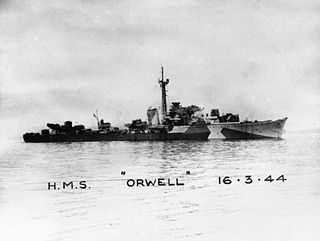
HMS Orwell was an O-class destroyer of the Royal Navy that entered service in 1942 and was broken up in 1965.
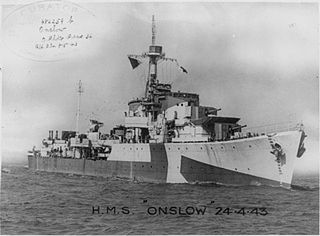
HMS Onslow was an O-class destroyer of the Royal Navy. The O-class were intermediate destroyers, designed before the outbreak of the Second World War to meet likely demands for large number of destroyers. They had a main gun armament of four 4.7 in guns, and had a design speed of 36 kn. Onslow was ordered on 2 October 1939 and was built by John Brown & Company at their Clydebank, Glasgow shipyard, launching on 31 March 1941 and completing on 8 October 1941.
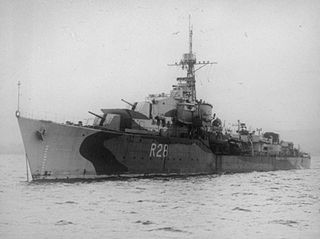
HMS Verulam was a V-class destroyer of the British Royal Navy that saw service during the Second World War.

HMS Paladin was a P-class destroyer of the Royal Navy that served in the Second World War. She was built by John Brown and Co. Ltd., Clydebank. She saw action in the Mediterranean and Far East. After the war she was converted into a type 16 frigate and was eventually scrapped in 1962.

HMS Zealous was a Z-class destroyer of the Royal Navy built in 1944 by Cammell Laird. She served during the Second World War, participating in operations in the North Sea and off the Norwegian coast, before taking part in some of the Arctic convoys. She spent a further ten years in Royal Navy service after the end of the war, before being sold to the Israeli Navy, which operated her as INS Eilat. She saw action during the Suez Crisis in 1956, attacking Egyptian ships and was still active by the outbreak of the Six-Day War in 1967. She was sunk several months after the conflict by missiles launched from several small Egyptian missile boats; this made her the first vessel to be sunk by a missile boat in wartime. It was an important milestone in naval surface warfare, which aroused considerable interest around the world in the development of small manoeuvrable missile boats.

HMS Beaufort was a Hunt-class destroyer of the Royal Navy. She was laid down on 17 July 1940 at Cammell Laird, Birkenhead. She was launched on 9 June 1941 and commissioned on 3 November 1941. During the Second World War the ship served in the Mediterranean Sea, escorting convoys and covering landings. She was transferred to the Royal Norwegian Navy in 1952 and scrapped in 1965.

HMS Westcott (D47) was a Royal Navy Admiralty W-class destroyer that served in the Second World War. In the Second World War Westcott served in an anti-submarine role and escorted numerous Atlantic and Malta convoys.

HMS Derwent was a Hunt-class Type III destroyer escort of the Royal Navy. She was built by Vickers-Armstrongs, in Barrow-in-Furness, and served during the Second World War. In March 1943, she was badly damaged while anchored in Tripoli harbour by aircraft and beached to prevent her from sinking. Temporarily repaired and towed to England, further repair work was halted in January 1945, and she was broken up for scrap in 1947.

HMS Albrighton was a Type III Hunt-class destroyer built for the British Royal Navy. She entered service in February 1942, first carrying out an attack on German ships in the English Channel then taking part in the Dieppe Raid, rescuing survivors from the sinking destroyer HMS Broke. Albrighton was next assigned to search for and destroy the German auxiliary cruiser Komet, then escorted a convoy to Gibraltar in prevision of the Allied landings in North Africa. Between December 1942 and April 1943, she participated in the sinking of three more Axis ships with the First Destroyer Flotilla. During the Normandy Landings in June 1944, Albrighton served as a headquarters ship, then sank two German trawlers in the weeks after the invasion. After being converted to a destroyer in early 1945, she was damaged in a collision with a Landing Ship, then was assigned to the British Eastern Fleet. However, the war ended before she was deployed and Albrighton went into reserve.

HMS Atherstone was a Hunt-class destroyer of the Royal Navy. She was launched in late 1939 as the first of her class but was found to be unstable, and had to undergo significant modifications before entering service in March 1940.
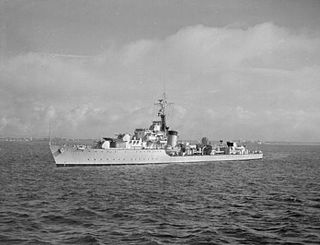
HMS Zephyr was a Z-class destroyer. She was launched on 13 July 1942 at Vickers-Armstrongs' High Walker shipyard and commissioned on 6 September 1944. She was 'adopted' by the civil community of Doncaster, replacing the destroyer HMS Lightning, which had originally been adopted during Warship Week in 1942.

HMS Brocklesby was a Type I Hunt-class destroyer of the Royal Navy. She served during the Second World War, spending much of the time in the English Channel and Mediterranean, taking part in the Dieppe Raid in 1942, and the Allied landings in Sicily and at Salerno in 1943. After the war, she was used as a sonar trials ship until 1963, and was sold for scrap in 1968.

HMS Campbell was an Admiralty type flotilla leader of the British Royal Navy. Built by Cammell Laird, Douglas commissioned in December 1918, just after the end of the First World War. During the Second World War, Campbell mainly served with as a convoy escort, particularly on the East Coast of the United Kingdom. She survived the war, and was sold for scrap in 1947.
HMS Talybont was a Type III Hunt-class escort destroyer who served in the Royal Navy. She was launched in February 1943 and completed in May that year, serving for the rest of the Second World War. She took part in the Normandy Landings in June 1944, supporting the landings at Omaha Beach and the Pointe du Hoc. Post war she served in the Mediterranean before being reduced to reserve at the end of 1947. She was sold for scrap in 1961, with disposal completed by 1962.

HMS Airedale was a Hunt-class destroyer built for use by the British Royal Navy during the Second World War. She entered service in early 1942 as a convoy escort, being assigned to the Mediterranean Fleet in May. Airedale was sunk while escorting a convoy from Alexandria to Malta on 15 June 1942 by Sturzkampfgeschwader 3.
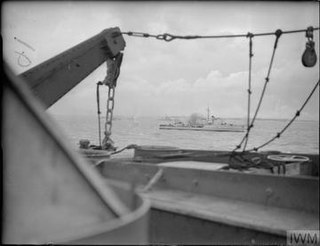
HMS Cottesmore was a Hunt-class destroyer of the British Royal Navy. The ship was built by the Scottish shipbuilder Yarrow at their Scotstoun, Glasgow shipyard in 1939–1940, being launched on 5 September 1940 and commissioning on 29 December that year.
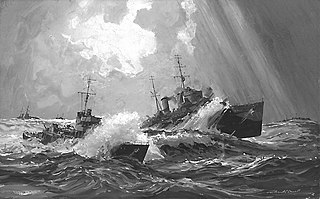
HMS Limbourne (L57) was a Hunt-class escort destroyer, operated by the Royal Navy. She was sunk in action, off German-occupied Guernsey, on 23 October 1943.

HMS Easton was a Type III Hunt-class destroyer of the British Royal Navy. Easton was built by the shipbuilder J Samuel White in 1941–1942, being launched on 11 July 1942 and completed on 7 December 1942.